Question Answer For All Chapters – Ganita Prakash Class 7th
Page 2
1. What if a person ate 3 varieties of rice every day? Will they be able to taste all the lakh varieties in a 100 year lifetime? Find out.
Ans: Varieties of rice eaten per day = 3
Number of days in 1 year = 365
So, rice varieties eaten in 1 year =
3 × 365 = 1,095 varieties
Now, rice varieties eaten in 100 years =
1,095 × 100 = 1,09,500 varieties
Yes, the person can taste all 1 lakh varieties of rice in 100 years.
2. Choose a number for y. How close to one lakh is the number of days in y years, for the y of your choice?
Ans: Let’s choose y = 274 years
Now calculate:
365 × 274 = 1,00,010 days
This is 10 days more than 1 lakh.
Let’s check for y = 273 years
365 × 273 = 99,645 days
This is 355 days less than 1 lakh.
At y = 274, we get 1,00,010 days, which is closest to 1 lakh.
So, y = 274 years gives a lifetime that is very close to 1 lakh days.
Figure it Out (Page 3)
1. According to the 2011 Census, the population of the town of Chintamani was about 75,000. How much less than one lakh is 75,000?
Ans: One lakh = 1,00,000
Population = 75,000
Now subtract:
1,00,000 − 75,000 = 25,000
75,000 is 25,000 less than one lakh.
2. The estimated population of Chintamani in 2024 is 106,000. How much more than one lakh is 1,06,000?
Ans: One lakh = 1,00,000
Estimated population = 1,06,000
Now subtract:
1,06,000 − 1,00,000 = 6,000
1,06,000 is 6,000 more than one lakh.
3. By how much did the population of Chintamani increase from 2011 to 2024?
Ans: Population in 2011 = 75,000
Estimated population in 2024 = 1,06,000
1,06,000 − 75,000 = 31,000
The population of Chintamani increased by 31,000 from 2011 to 2024
Getting a Feel of Large Numbers – Page 3
Look at the picture on the right. Somu is 1 metre tall. If each floor is about four times his height, what is the approximate height of the building?
Ans: Somu’s height = 1 meter.
Each floor ≈ 4 × 1 = 4 meters.
The building in the picture has 10 floors.
Height of building = 11 × 4 = 40 meters.
Approximately 44 meters.
1. Which is taller — The Statue of Unity or this building? How much taller? __________ m
Ans: The height of the Statue of Unity is 180 metres, and the height of the building is 44 metres.
To find how much taller the statue is, we subtract:
180 − 44 = 136 metres
So, the Statue of Unity is 136 metres taller than the building.
2. How much taller is the Kunchikal waterfall than Somu’s building? __________ m
Ans: Height of Kunchikal waterfall = 450 metres
Height of Somu’s building = 44 metres
450 − 44 = 406 metres
3. How many floors should Somu’s building have to be as high as the waterfall?
Ans: Height of Kunchikal waterfall = 450 metres
Each floor of Somu’s building = 4 metres
Calculation: 450 ÷ 4 = 112.5
Somu’s building should have 113 floors to be as high as the Kunchikal waterfall.
Is One Lakh a Very Large Number? Page – 4
How do you view a lakh — is a lakh big or small?
Ans: A lakh can feel big or small depending on the situation:
It feels big when we talk about money, varieties of rice, or living 1 lakh days.
It feels small when we talk about stadium capacity, number of hairs, or fish eggs.
Reading and Writing Numbers (Pages 4-5)
1. Write each of the numbers given below in words:
(a) 3,00,600
(b) 5,04,085
(c) 27,30,000
(d) 70,53,138
Ans: (a) 3,00,600 → Three lakh six hundred
(b) 5,04,085 → Five lakh four thousand eighty-five
(c) 27,30,000 → Twenty-seven lakh thirty thousand
(d) 70,53,138 → Seventy lakh fifty-three thousand one hundred thirty-eight
2. Write the corresponding number in the Indian place value system for each of the following:(a) One lakh twenty three thousand four hundred and fifty six
(b) Four lakh seven thousand seven hundred and four
(c) Fifty lakhs five thousand and fifty
(d) Ten lakhs two hundred and thirty five
Ans: (a) 1,23,456
(b) 4,07,704
(c) 50,05,050
(d) 10,00,235
1.2 Land of Tens (Page 5-6)
1. The Thoughtful Thousands only has a +1000 button. How many times should it be pressed to show:
(a) Three thousand? 3 times
(b) 10,000? ____________
(c) Fifty three thousand? ___________
(d) 90,000? ______________
(e) One Lakh? ________________
(f) ____________? 153 times
(g) How many thousands are required to make one lakh?
Ans: (a) Three thousand → 3 times (Already given)
(b) 10,000 ÷ 1000 = 10 times
(c) 53,000 ÷ 1000 = 53 times
(d) 90,000 ÷ 1000 = 90 times
(e) 1,00,000 ÷ 1000 = 100 times
(f) 153 × 1000 = 1,53,000
(g) To make one lakh:
1,00,000 ÷ 1000 = 100 thousands
2. The Tedious Tens only has a +10 button. How many times should it be pressed to show:
(a) Five hundred? _____________
(b) 780? _________
(c) 1000? _________
(d) 3700? ________
(e) 10,000? ___________
(f) One lakh? _____________
(g) ____________? 435 times
Ans: (a) 500 ÷ 10 = 50 times
(b) 780 ÷ 10 = 78 times
(c) 1000 ÷ 10 = 100 times
(d) 3700 ÷ 10 = 370 times
(e) 10,000 ÷ 10 = 1000 times
(f) 1,00,000 ÷ 10 = 10,000 times
(g) 435 × 10 = 4350
3. The Handy Hundreds only has a +100 button. How many times should it be pressed to show:
(a) Four hundred? __________ times
(b) 3,700? __________
(c) 10,000? __________
(d) Fifty-three thousand? __________
(e) 90,000? __________
(f) 97,600? __________
(g) 1,00,000? __________
(h) __________? 582 times
(i) How many hundreds are required to make ten thousand?
(j) How many hundreds are required to make one lakh?
(k) Handy Hundreds says, “There are some numbers which Tedious Tens and Thoughtful Thousands can’t show but I can.” Is this statement true? Think and explore.
Ans: (a) 400 ÷ 100 = 4 times
(b) 3,700 ÷ 100 = 37 times
(c) 10,000 ÷ 100 = 100 times
(d) 53,000 ÷ 100 = 530 times
(e) 90,000 ÷ 100 = 900 times
(f) 97,600 ÷ 100 = 976 times
(g) 1,00,000 ÷ 100 = 1000 times
(h) 582 × 100 = 58,200
(i) To make 10,000 → 100 hundreds
(j) To make 1,00,000 → 1000 hundreds
(k) Yes, it’s true.
For example, to show 510, you can press:
5 × 100 + 1 × 10, which Tedious Tens can do.
But Thoughtful Thousands cannot show it.
For 550, Tedious Tens would need 55 presses, but Handy Hundreds can do it in 5.5 presses — which it can’t actually perform without decimals.
However, Handy Hundreds can represent values that neither of the other two can do efficiently or exactly.
4. Creative Chitti is a different kind of calculator. It has the following buttons: +1, +10, +100, +1000, +10000, +100000 and +1000000. It always has multiple ways of doing things. “How so?”, you might ask. To get the number 321, it presses +10 thirty two times and +1 once. Will it get 321? Alternatively, it can press +100 two times and +10 twelve times and +1 once.
Ans:
Way 1:
- Press +10 button 32 times = 32 × 10 = 320
- Press +1 button 1 time = 1
- 320 + 1 = 321
- Yes, this gives 321
Way 2:
- Press +100 button 2 times = 2 × 100 = 200
- Press +10 button 12 times = 12 × 10 = 120
- Press +1 button 1 time = 1
- 200 + 120 + 1 = 321
- This also gives 321
5. Two of the many different ways to get 5072 are shown below:
These two ways can be expressed as:
(a) (50 × 100) + (7 × 10) + (2 × 1) = 5072
(b) (3 × 1000) + (20 × 100) + (72 × 1) = 5072
Find a different way to get 5072 and write an expression for the same.
Ans: Here, (5 × 1000) + (0 × 100) + (7 × 10) + (2 × 1)
= 5000 + 0 + 70 + 2
= 5072
Figure it Out (Page 6-7)
For each number given below, write expressions for at least two different ways to obtain the number through button clicks. Think like Chitti and be creative.
(а) 8300
(b) 40629
(c) 56354
(d) 66666
(e) 367813
Ans: (a) 8300
Way 1:
= 8 × 1000 + 3 × 100
= 8000 + 300 = 8300
Way 2:
= 83 × 100
= 8300
(b) 40629
Way 1:
= 4 × 10000 + 0 × 1000 + 6 × 100 + 2 × 10 + 9 × 1
= 40000 + 0 + 600 + 20 + 9 = 40629
Way 2:
= 40 × 1000 + 600 + 20 + 9
= 40000 + 600 + 20 + 9 = 40629
(c) 56354
Way 1:
= 5 × 10000 + 6 × 1000 + 3 × 100 + 5 × 10 + 4 × 1
= 50000 + 6000 + 300 + 50 + 4 = 56354
Way 2:
= 56 × 1000 + 3 × 100 + 5 × 10 + 4
= 56000 + 300 + 50 + 4 = 56354
(d) 66666
Way 1:
= 6 × 10000 + 6 × 1000 + 6 × 100 + 6 × 10 + 6
= 60000 + 6000 + 600 + 60 + 6 = 66666
Way 2:
= 66 × 1000 + 666
= 66000 + 666 = 66666
(e) 367813
Way 1:
= 3 × 100000 + 6 × 10000 + 7 × 1000 + 8 × 100 + 1 × 10 + 3
= 300000 + 60000 + 7000 + 800 + 10 + 3 = 367813
Way 2:
= 36 × 10000 + 7813
= 360000 + 7813 = 367813
Page – 7
1. Creative Chitti has some questions for you-
(a) You have to make exactly 30 button presses. What is the largest 3-digit number you can make? What is the smallest 3-digit number you can make?
Ans: (a) For the largest 3-digit number:
Press the +100 button 9 times: 9 × 100 = 900
Add 10 more presses using the +10 button: 10 × 10 = 100
Add the remaining 11 presses using the +1 button: 11 × 1 = 11
Sum: 900 + 100 + 11 = 1011, but that’s a 4-digit number.
Scale back by reducing the number of +10 presses to 8 and +1 presses to 13.
Largest 3-digit number: 993 (9 × 100 + 8 × 10 + 13 × 1)
For the smallest 3-digit number
Press the +10 button 8 times: 8 × 10 = 80
Add 22 more presses using the +1 button: 22 × 1 = 22
Smallest 3-digit number: 102 (8 × 10 + 22 × 1)
(b) 997 can be made using 25 clicks. Can you make 997 with a different number of clicks?
Ans: 9 × (+100) = 900
8 × (+10) = 80
17 × (+1) = 17
Figure it Out (Page – 7)
1. For the numbers in the previous exercise, find out how to get each number by making the smallest number of button clicks and write the expression.
Ans: (a) Here, 8300
(8 × 1,000) + (3 × 100) = 8300
Hence, 8300 can be obtained in 8 + 3 = 11 clicks.
(b) Here, 40629
(4 × 10,000) + (6 × 100) + (2 × 10) + (9 × 1) = 40629
Hence, 40629 can be obtained in 4 + 6 + 2 + 9 = 21 clicks.
(c) Here, 56354
(5 × 10,000) + (6 × 1,000) + (3 × 100) + (5 × 10) + (4 × 1) = 56354
Hence, 56354 can be obtained in 5 + 6 + 3 + 5 + 4 = 23 clicks.
(d) Here, 66666
(6 × 10,000) + (6 × 1,000) + (6 × 100) + (6 × 10) + (6 × 1) = 66666
Hence, 66666 can be obtained in 6 + 6 + 6 + 6 + 6 = 30 clicks.
(e) We have 367813
(3 × 1,00,000) +(6 × 10,000) + (7 × 1,000) + (8 × 100) + (1 × 10) + (3 × 1) = 367813
Hence, 367813 can be obtained in 3 + 6 + 7 + 8 + 1 + 3 = 28 clicks.
2. Do you see any connection between each number and the corresponding smallest number of button clicks?
Ans: Yes, there is a clear connection:
The smallest number of button clicks needed to make a number depends directly on its place values — that is, how many non-zero digits the number has and in which places.
3. If you notice, the expressions for the least button clicks also give the Indian place value notation of the numbers. Think about why this is so.
Ans: Yes, this is true — and here’s why:
When we express a number using the fewest button clicks, we break it into its place values:
- Lakh
- Ten-thousand
- Thousand
- Hundred
- Ten
- One
These are exactly the same place values used in the Indian place value system.
Of Crores and Crores! (Page – 8, 9)
1. How many zeros does a thousand lakh have? _____
Ans: 1,000 lakh = 10,00,00,000 (8 zeros)
2. How many zeros does a hundred thousand have?
Ans: 100 thousand = 1,00,000 (5 zeros)
Figure it Out (Page 9)
1. Read the following numbers in Indian place value notation and write their number names in both the Indian and American systems:
(a) 4050678 (b) 48121620
(c) 20022002 (d) 246813579
(e) 345000543 (f) 1020304050
Ans: (a) 4050678
- Indian notation: 40,50,678
- Indian system name: Forty lakh fifty thousand six hundred seventy-eight
- American notation: 4,050,678
- American system name: Four million fifty thousand six hundred seventy-eight
(b) 48121620
- Indian notation: 4,81,21,620
- Indian system name: Four crore eighty-one lakh twenty-one thousand six hundred twenty
- American notation: 48,121,620
- American system name: Forty-eight million one hundred twenty-one thousand six hundred twenty
(c) 20022002
- Indian notation: 2,00,22,002
- Indian system name: Two crore twenty-two thousand two
- American notation: 20,022,002
- American system name: Twenty million twenty-two thousand two
(d) 246813579
- Indian notation: 24,68,13,579
- Indian system name: Twenty-four crore sixty-eight lakh thirteen thousand five hundred seventy-nine
- American notation: 246,813,579
- American system name: Two hundred forty-six million eight hundred thirteen thousand five hundred seventy-nine
(e) 345000543
- Indian notation: 34,50,00,543
- Indian system name: Thirty-four crore fifty lakh five hundred forty-three
- American notation: 345,000,543
- American system name: Three hundred forty-five million five hundred forty-three
(f) 1020304050
- Indian notation: 1,02,03,04,050
- Indian system name: One arab two crore three lakh four thousand fifty
- American notation: 1,020,304,050
- American system name: One billion twenty million three hundred four thousand fifty
2. Write the following numbers in Indian place value notation:
(a) One crore one lakh one thousand ten
(b) One billion one million one thousand one
(c) Ten crore twenty lakh thirty thousand forty
(d) Nine billion eighty million seven hundred thousand six hundred
Ans: (a) 1,01,01,010
(b) 1,001,001,001
(c) 10,20,30,040
(d) 9,080,700,600
3. Compare and write ‘<’, ‘>’ or ‘=’:
(a) 30 thousand ____ 3 lakhs
(b) 500 lakhs ______ 5 million
(c) 800 thousand ____ 8 million
(d) 640 crore ______ 60 billion
(a) 30 thousand ____ 3 lakhs
Ans: 30 thousand = 30,000
- 3 lakhs = 3,00,000
- 30,000 < 3,00,000
(b) 500 lakhs ______ 5 million
Ans:
- 1 million = 10 lakhs
- So, 5 million = 50 lakhs
- 500 lakhs > 50 lakhs
(c) 800 thousand ____ 8 million
Ans:
- 800 thousand = 800,000
- 8 million = 8,000,000
- 800,000 < 8,000,000
(d) 640 crore ______ 60 billion
Ans:
- 1 billion = 100 crore
- So, 60 billion = 60 × 100 = 6,000 crore
- 640 crore < 6,000 crore
Nearest Neighbours (Pages 11-12)
1. write the five nearest neighbours for these numbers:
(a) 3,87,69,957
(b) 29,05,32,481
Ans: (a) 3,87,69,957
- Nearest thousand → 3,87,70,000
- Nearest ten thousand → 3,87,70,000
- Nearest lakh → 3,88,00,000
- Nearest ten lakh → 3,90,00,000
- Nearest crore → 4,00,00,000
(b) 29,05,32,481
- Nearest thousand → 29,05,32,000
- Nearest ten thousand → 29,05,30,000
- Nearest lakh → 29,05,00,000
- Nearest ten lakh → 29,10,00,000
- Nearest crore → 29,00,00,000
Figure it Out (Page 11)
1. 4,63,128 + 4,19,682,
Roxie: “The sum is nearly 8,00,000 and is more than 8,00,000.”
Estu: “The sum is nearly 9,00,000 and is less than 9,00,000.”
(a) Are these estimates correct? Whose estimate is closer to the sum?
(b) Will the sum be greater than 8,50,000 or less than 8,50,000? Why do you think so?
(c) Will the sum be greater than 8,83,128 or less than 8,83,128? Why do you think so?
(d) Exact value of 4,63,128 + 4,19,682 = _____________
Ans: (a) By adding 4,63,128 and 4,19,682, we get 8,82,810 and the estimated sum is 5,00,000 + 4,00,000 = 9,00,000
The exact sum is 8,82,810, which is closer to 9,00,000.
Thus, Estu’s estimate is correct and closer to the actual sum.
(b) The exact sum is 8,82,810, which is clearly greater than 8,50,000.
If we estimate the two numbers (4,63,128 and 4,19,682) to the nearest ten thousands, we get 4,60,000 and 4,20,000.
By adding them, the results will be closer to 8,80,000, which is well above 8,50,000.
(c) The exact sum is 8,82,810, which is less than 8,83,128.
The sum falls short of 8,83,128 by only 318, making it closer to the actual sum.
(d) Exact value of 4,63,128 + 4,19,682 = 8,82,810
2. 14,63,128 – 4,90,020
Roxie: “The difference is nearly 10,00,000 and is less than 10,00,000.”
Estu: “The difference is nearly 9,00,000 and is more than 9,00,000”.
(a) Are these estimates correct? Whose estimate is closer to the difference?
(b) Will the difference be greater than 9,50,000 or less than 9,50,000? Why do you think so?
(c) Will the difference be greater than 9,63,128 or less than 9,63,128? Why do you think so?
(d) Exact value of 14,63,128 – 4,90,020 = ___________
Ans: (a) Exact difference = 14,63,128 – 4,90,020 = 9,73,108
Estimated difference = 15,00,000 – 5,00,000 = 10,00,000
Roxie’s estimate is closer to the actual difference.
(b) Exact difference = 9,73,108
It is greater than 9,50,000.
Now estimating the numbers 14,63,128 and 4,90,020 to the nearest ten thousands place, we get 14,60,000 and 4,90,000 respectively.
Now, Difference = 14,60,000 – 4,90,000 = 9,70,000
It is more than 9,50,000.
(c) Exact difference is 9,73,108
It is greater than 9,63,128.
Difference = 9,73,108, – 9,63,128 = 9,980
It is far from the actual difference.
(d) Exact value = 14,63,128 – 4,90,020 = 9,73,108
Population of Cities (Pages 12-13)
1. What is your general observation about this data? Share with the class.
Ans: The population of all 20 cities has increased between 2001 and 2011.
2. What is an appropriate title for the above table?
Ans: “Population Growth of Indian Cities (2001–2011)”
3. How much is the population of Pune in 2011? Approximately, by how much has it increased compared to 2001?
Ans: Population of Pune in 2011 = 31,15,431 and in 2001 = 25,38,473
Approximate Increase in population: 31,00,000 – 25,00,000 = 6,00,000
4. Which city’s population increased the most between 2001 and 2011?
Ans: Bengaluru experienced the largest population increase, with a growth of 41,24,644 people.
5. Are there cities whose population has almost doubled? Which are they?
Ans: Bengaluru, Hyderabad, Surat, Vadodara, and Pimpri-Chinchwad nearly doubled their population between 2001 and 2011.
6. By what number should we multiply Patna’s population to get a number/population close to that of Mumbai?
Ans: Mumbai’s population by Patna’s population in 2011 =\( \frac{1,24,42,373}{16,84,222}\) ~ 7
Patna’s population needs to be multiplied by 7 to be close to Mumbai’s population.
1.5 Patterns in Products (Page 14)
Using the meaning of multiplication and division, can you explain why multiplying by 5 is the same as dividing by 2 and multiplying by 10?
Ans: Multiplying by 5 is the same as multiplying by 10 and then dividing by 2 because
\(\frac{10}{2}\) = (10 ÷ 2)/(2 ÷ 2) = 5
Figure It Out (Page 14)
1. Find quick ways to calculate these products:
(a) 2 × 1768 × 50
Ans: (2×50)×1768=100×1768=1,76,800
(b) 72 × 125 [Hint: 125 = \(\frac{1000}{8}\) ]
Ans: Hint: 125 = \(\frac{1000}{8}\)
72×125=72×\(\frac{1000}{8}\)=\(\frac{72}{8}\)×1000=9×1000=9000
(c) 125 × 40 × 8 × 25
Ans: (125×8)×(40×25) = 1000×1000=10,00,000
2. Calculate these products quickly.
(a) 25 × 12 = _____________
(b) 25 × 240 = _____________
(c) 250 × 120 = _____________
(d) 2500 × 12 =_____________
(e) ______×______= 120000000
Ans:
(a) 25 × 12 = 25×12 = (25×4)×3 = 100×3 = 300
(b) 25 × 240 = 25×240=(25×4)×60=100×60=6000
(c) 250 × 120 = 250×120 = (25×12)×100 = 300×100 = 30,000
(d) 2500 × 12 = 2500×12 = (25×12)×100 = 300×100 = 30,000
(e) ______ × ______ = 120000000
One quick way:12,000×10,000 = 1,20,00,000
How Long is the Product?
In each of the following boxes, the multiplications produce interesting patterns. Evaluate them to find the pattern. Extend the multiplications based on the observed pattern.
Ans:
Q. Observe the number of digits in the two numbers being multiplied and their product in each case. Is there any connection between the numbers being multiplied and the number of digits in their product?
Ans: Yes
1- digit × 1-digit = 1 or 2 digits
2- digit × 2-digit = 3 or 4 digits
3- digit × 3-digit = 5 or 6 digits
4-digit × 4-digit = 7 or 8 digits
Q. Roxie says that the product of two 2-digit numbers can only be a 3- or a 4-digit number. Is she correct?
Ans: Yes Roxie is correct.
The smallest 2-digit number is 10.
10×10 = 100 (That is a 3-digit number.)
The largest 2-digit number is 99.
99×99 = 9801 (That is a 4-digit number.)
Q. Should we try all possible multiplications with 2-digit numbers to tell whether Roxie’s claim is true? Or is there a better way to find out?
Ans: We don’t need to check every multiplication; looking at the extremes — 10×10 for the minimum and 99×99 for the maximum — is enough to know the possible number of digits.
Q. Can multiplying a 3-digit number with another 3-digit number give a 4-digit number?
Ans: The smallest 3-digit number is 100.
Multiplying two 3-digit numbers:
100×100 = 10,000 (This is already a 5-digit number.)
So the product of two 3-digit numbers will always be at least 10,000 (5 digits).
Therefore, a 3-digit × 3-digit product cannot be a 4-digit number.
Q. Observe the multiplication statements below. Do you notice any patterns? See if this pattern extends for other numbers as well.
Ans: 1-digit × 1-digit = 1-digit or 2-digit
2-digit × 1-digit = 2-digit or 3-digit
2-digit × 2-digit = 3-digit or 4-digit
3-digit × 3-digit = 5-digit or 6-digit
5-digit × 5-digit = 9-digit or 10-digit
8-digit × 3-digit = 10-digit or 11-digit
12-digit × 13-digit = 24-digit or 25-digit
Quick examples to see the rule:
Smallest 2-digit × 2-digit: 10×10 = 100 → 3 digits (= 2 + 2 – 1)
Largest 2-digit × 2-digit: 99×99 = 9801 → 4 digits (= 2 + 2)
Smallest 3-digit × 3-digit: 100×100 = 10,000 → 5 digits (= 3 + 3 – 1)
Largest 3-digit × 3-digit: 999×999 = 998001 → 6 digits (= 3 + 3)
5- digit × 5-digit = 9-10 digits (Min = 5 + 5 – 1, Max = 5 + 5)
8 digit × 3-digit = 10-11 digits (Min = 8 + 3 – 1, Max = 8 + 3)
12 digit × 13-digit = 24-25 digits (Min = 12 + 13 – 1, Max = 12 + 13)
Fascinating Facts about Large Numbers (Page 16)
(Que.) 1250 × 380 __________ is the number of Kirtanas composed by Purandaradasa according to legends.
Ans: Kīrtanas = 1250×380
= (125×10)×(38×10)
= 125×38×100
= 4750×100 = 4,75,000
(Que.)
Ans: Distance = 2100 × 70,000
= (21 × 1,000) × (7 × 10,000)
= 21 × 7 × 1,000 × 10,000
= 147 × 1,00,00,000 = 1,47,00,00,000 km
(Que.)
Ans: 6400×62,500=(64×100)×(625×100)
=(64×625)×(100×100)
Now, 64×625=40,000.
So, 6400×62,500 = 40,000×10,000 = 4,00,00,000
4,00,00,000 litres per second
(Que.)
Ans: First simplify:
13,95,000÷150 = \(\frac{13,95,000}{150}\)
Divide numerator and denominator by 10: \(\frac{1,39,500}{15}\)
Now divide: 1,39,500÷15 = 9300km
(Que.)
Ans: Let’s calculate step by step
10,50,00,000÷700
First, write it clearly:=\(\frac{1,05,00,0000}{700}\)
\(\frac{105}{7}\)×\(\frac{10000000}{100}\) = 1,50,000 kg
(Que.)
weight (in tonnes) = \(\frac{52,00,00,00,000}{130}\) = 40,00,00,000
1.6 Did You Ever Wonder…? (Page 16)
Q. The RMS Titanic ship carried about 2500 passengers. Can the population of Mumbai fit into 5000 such ships?
Ans: Let’s check step by step
Capacity of one Titanic ship = 2500 passengers
Number of ships = 5000
Total capacity = 5000×2500=1,25,00,000(1.25 crore people)
Population of Mumbai (2011) = 1,24,42,373 (about 1.24 crore)
Find out if you can reach the Sun in a lifetime, if you travel 1000
kilometers every day. (You had written down the distance between the
Earth and the Sun in a previous exercise.)
Q. How far would she have travelled in a year?
Ans: Distance travelled by Roxie in a year = 100 km/day × 365 days = 36500 km
Q. How far would she have travelled in 10 years?
Ans: We already know Roxie travels 36,500 km in one year.
For 10 years: 36,500×10=3,65,000km
Q. Is it not easier to perform these calculations in stages? You can use this method for all large calculations.
Ans: Yes, exactly
It is much easier to handle large calculations in smaller stages.
Q. Find out if you can reach the Sun in a lifetime, if you travel 1000 kilometers every day. (You had written down the distance between the Earth and the Sun in a previous exercise.)
Ans: Distance between Earth and Sun≈14,70,00,000km(147million km)
Distance travelled in 1 year
If you travel 1000 km every day: 1000×365=3,65,000km per year
Distance travelled in 100 years (a lifetime): 3,65,000×100=3,65,00,000km
Compare with Earth–Sun distance –
Distance to Sun = 14,70,00,000 km
Distance covered in lifetime = 3,65,00,000 km
Clearly, 3,65,00,000<14,70,00,000
Q. Make necessary reasonable assumptions and answer the questions below:
(a) If a single sheet of paper weighs 5 grams, could you lift one lakh sheets of paper together at the same time?
(a) Weight of 1 lakh sheets
Ans: Weight of 1 sheet = 5 g
Weight of 1 lakh sheets = 1,00,000×5=5,00,000g
Convert to kilograms: \(\frac{5,00,000g}{1000}\) = 500 kg
500 kg is too heavy for a person to lift at once, so the answer is No.
(b) If 250 babies are born every minute across the world, will a million babies be born in a day?
Ans: Babies born in a day
250 babies/minute
Babies per hour = 250×60=15,000
Babies per day = 15,000×24=3,60,000
Only 3,60,000 babies are born in a day, which is less than 1 million.
So the answer is No
(c) Can you count 1 million coins in a day? Assume you can count 1 coin every second.
Ans: In 1 second, you can count 1 coin.
In 1 minute, that becomes 60 coins.
In 1 hour, you would count 60×60=3,600 coins.
In 1 whole day, you would count 3,600×24=86,400 coins.
Since 86,400 is far less than 10,00,000 (1 million), it is not possible to count 1 million coins in a single day.
Figure it Out (Pages 19-21)
1. Using all digits from 0 – 9 exactly once (the first digit cannot be 0) to create a 10-digit number, write the —
(a) Largest multiple of 5
(b) Smallest even number
(a) Largest multiple of 5
Ans: To get the largest number, arrange digits in descending order.
Digits 9 to 0 in descending order = 9876543210
This ends in 0, so it is a multiple of 5.
Largest multiple of 5 = 9876543210
(b) Smallest even number
Ans: To get the smallest number, arrange digits in ascending order, but the first digit cannot be 0.
So start with 1, then place the remaining digits in ascending order.
1023456789
This ends in 9 (odd), not even. We must adjust.
To make it even, put 2 at the end and arrange others ascending: 1034567892
Smallest even number = 1034567892
2. The number 10,30,285 in words is Ten lakhs thirty thousand two hundred eighty five, which has 43 letters. Give a 7-digit number name which has the maximum number of letters.
Ans: Since the words seven and eight both have 5 letters, they can be used to form long number names.
For 77,77,777, the number name is Seventy-seven lakh seventy-seven thousand seven hundred seventy-seven.
Total letters = 60.
For 88,88,888, the number name is Eighty-eight lakh eighty-eight thousand eight hundred eighty-eight.
Total letters = 57.
Therefore, among these, 77,77,777 has the maximum number of letters in its number name.
3. Write a 9-digit number where exchanging any two digits results in a bigger number. How many such numbers exist?
Ans: Number must be the smallest possible = 123456789
Any swap, for example, 213456789, is larger.
4. Strike out 10 digits from the number 12345123451234512345 so mthat the remaining number is as large as possible.
Ans: The given number is 12345123451234512345.
After removing the 10 smallest digits from the left, the number we get is 5534512345.
5. The words ‘zero’ and ‘one’ share letters ‘e’ and ‘o’. The words ‘one’ and ‘two’ share a letter ‘o’, and the words ‘two’ and ‘three’ also share a letter ‘t’. How far do you have to count to find two consecutive numbers which do not share an English letter in common?
Ans:
Zero and One → share o, e
One and Two → share o
Two and Three → share t
Three and Four → share r
Four and Five → share f
Five and Six → share i
Six and Seven → share s
Seven and Eight → share e
Eight and Nine → share n
Nine and Ten → share n, e
Ten and Eleven → share e, n
Eleven and Twelve → share e
Twelve and Thirteen → share t, e
Thirteen and Fourteen → share t, e, n
Fourteen and Fifteen → share f, t, e, n
It shows that every pair of consecutive numbers shares at least one common letter. Therefore, there is no pair of consecutive numbers whose English names are completely free of shared letters.
6. Suppose you write down all the numbers 1, 2, 3, 4, …, 9, 10, 11, … The tenth digit you write is ‘1’ and the eleventh digit is ‘0’, as part of the number 10.
(a) What would the 1000th digit be? At which number would it occur?
(b) What number would contain the millionth digit?
(c) When would you have written the digit ‘5’ for the 5000th time?
Ans: (a) 1–9 → 9 digits (total 9)
10–99 → 90×2 = 180 digits (total 189)
Total digits from 1 to 99 = 180 + 9 = 189 digits
Remaining digits to reach 1000th digit = 1000 – 189 = 811
Numbers with 3-digit numbers = \(\frac{811}{3}\) = 270
Thus, first we need to write the first 270 3-digit numbers starting from 100.
So, the 270th 3-digit number = 100 + 270 – 1 = 369.
The next number is 370.
Thus, the 1000th digit is the 1st digit of 370, which is 3.
(b) For 1-digit numbers (1–9) → 9
For 2-digit numbers (10–99) → 90×2= 180 digits.
Total so far = 9 + 180 = 189.
For 3-digit numbers (100–999) → 900×3=2700 digits.
Total = 189 + 2700 = 2889.
For 4-digit numbers (1000–9999) →9000×4=36,000 digits
Total = 2889 + 36,000 = 38,889.
For 5-digit numbers (10,000–99,999) → 90,000×5=4,50,000 digits
Total = 38,889 + 4,50,000 = 4,88,889.
So, up to all 5-digit numbers, we have written 4,88,889 digits.
To reach the millionth digit: 1,000,000−4,88,889=5,11,111 digits left
These are within the 6-digit numbers.
Each 6-digit number uses 6 digits.
5,11,111÷6=85,185 complete numbers, remainder 1
So, the millionth digit will be the first digit of the 85,186th 6-digit number.
The first 6-digit number is 1,00,000.
Adding 85,185 numbers brings us to: 1,00,000+85,186−1=1,85,185
(c) 1-digit numbers (1–9):
‘5’ appears only once (in the number 5).
Total so far = 1
2-digit numbers (10–99):
In the tens place → 50 to 59 → 10 times
In the ones place → 15, 25, … 95 → 9 times
Total = 10 + 9 = 19
Running total = 1 + 19 = 20
3-digit numbers (100–999):
Hundreds place = 100 (500–599)
Tens place = 90
Ones place = 90
Total = 280
Running total = 20 + 280 = 300
4-digit numbers (1000–9999):
Thousands place = 1000 (5000–5999)
Hundreds = 900
Tens = 900
Ones = 900
Total = 3700
Running total = 300 + 3700 = 4000
Now we need the 5000th ‘5’.
Already we have 4000.
So we need 1000 more ‘5’s from 5-digit numbers (10,000 onwards).
Step inside 5-digit numbers
10,000–10,999:
‘5’ comes 300 times.
Running total = 4300
11,000–11,999:
Again 300 times.
Running total = 4600
12,000–12,999:
Again 300 times.
Running total = 4900
13,000–13,999:
We need only 100 more to reach 5000.
In this block:
Units place alone gives 100 fives (13500–13599).
So the 5000th ‘5’ is the last unit digit of 13,995.
The 5000th occurrence of the digit ‘5’ happens in the number 13,995 (at the unit’s place).
7. A calculator has only ‘+10,000’ and ‘+100’ buttons. Write an expression describing the number of button clicks to be made for the following numbers:
(a) 20,800
(b) 92,100
(c) 1,20,500
(d) 65,30,000
(e) 70,25,700
Ans:
(a) 20,800
20,000 = 2×10,000
800 = 8×100
20,800 = 2 × (10,000) + 8 × (100)
Number of clicks = 2 + 8 = 10 clicks
(b) 92,100
90,000 = 9×10,000
2,100 = 21×100
92,100 = 9 × (10,000) + 21 × (100)
Total clicks = 9 + 21 = 30 clicks.
(c) 1,20,500
1,20,000 = 12×10,000
500 = 5×100
1,20,500 = 12 × (10,000) + 5 × (100)
12 + 5 = 17 clicks
(d) 65,30,000
5,30,000 = 653×10,000
65,30,000 = 653 × (10,000)
Number of clicks = 653 + 0 = 653 clicks
(e) 70,25,700
70,20,000 = 702×10,000
5,700 = 57×100
Number of clicks = 702 + 57 = 759 clicks
8. How many lakhs make a billion?
Ans:
1 billion in digits
1 billion = 1,000,000,000
Convert into lakhs
1 lakh = 100,000 = 1,00,000
Now,
\(\frac{1,000,000,000}{100,000}\) = 10,000
1 billion = 10,000 lakhs
9. You are given two sets of number cards numbered from 1 – 9. Place a number card in each box below to get the (a) largest possible sum (b) smallest possible difference of the two resulting numbers.
Ans: (a) Largest possible sum
To make the sum as big as possible, choose the biggest digits for both numbers.
The largest 7-digit number with digits 1–9 is 98,76,543.
The largest 5-digit number with digits 1–9 is 98,765.
Adding them:
98,76,543+98,765=99,75,308
So, the largest possible sum = 99,75,308.
b) Smallest possible difference
To make the difference as small as possible, take the smallest 7-digit number and the largest 5-digit number.
The smallest 7-digit number with digits 1–9 is 12,34,567.
The largest 5-digit number with digits 1–9 is 98,765.
Subtracting them:
12,34,567−98,765 = 11,35,802
So, the smallest possible difference = 11,35,802.
10. You are given some number cards; 4000, 13000, 300, 70000, 150000, 20, 5. Using the cards get as close as you can to the numbers below using any operation you want. Each card can be used only once for making a particular number.
(a) 1,10,000: Closest I could make is 4000 × (20 + 5) + 13000 = 1,13,000
(b) 2,00,000:
(c) 5,80,000:
(d) 12,45,000:
(e) 20,90,800:
Ans: (a) Expression: 4000×(20+5)+13,000 = 4,000×25+13,000 = 100,000+13,000 = 1,13,000.
(b) Expression: 1,50,000 + 70,000 – 4000 × 5 = 2,00,000
(c) Expression: (4,000×20)+(70,000×5)+150,000 = 80,000+350,000+150,000 = 580,000.
(d) Expression: 70,000 × 20 – 1,50,000 – 4,000 – 300 × 5
= 14,00,000 – 1,50,000 – 4,000 – 1,500 = 12,44,500
(e) Expression: 13,000 × 300 – 70,000(20 + 5) – 1,50,000 + 4,000 = 20,04,000
11. Find out how many coins should be stacked to match the height of the Statue of Unity. Assume each coin is 1 mm thick.
Ans: From the chapter the Statue of Unity is given as about 180 metres tall.
1 coin = 1 mm thick.
1 metre = 1000 mm.
So, 180 m=180×1000 mm=180,000 mm.
Therefore you would need 180,000 coins stacked (1 mm each) to match the statue’s height.
12. Grey-headed albatrosses have a roughly 7-foot wingspan. They are known to migrate across several oceans. Albatrosses can cover about 900-1000 km in a day. One of the longest single trips recorded is about 12,000 km. How many days would such a trip take to cross the Pacific Ocean approximately?
Ans: Grey-headed albatross average daily travel = 900–1000 km/day.
Longest single trip = 12,000 km.
Now divide distance by speed: Days = \(\frac{12,000}{Daily Distance}\)
At 900 km/day → \(\frac{12,000}{900}\) = 13.3 days
At 1000 km/day → \(\frac{12,000}{1000}\) = 12 days
It would take the albatross about 12–13 days to complete a 12,000 km trip across the Pacific Ocean.
13. A bar-tailed godwit holds the record for the longest recorded non-stop flight. It travelled 13,560 km from Alaska to Australia without stopping. Its journey started on 13 October 2022 and continued for about 11 days. Find out the approximate distance it covered every day. Find out the approximate distance it covered every hour.
Ans: The bird flew a total of 13,560 km in 11 days.
Since one day has 24 hours, the total time of the journey = 11×24=264 hours.
Distance covered in one day:
13,560÷11=1,232.7km≈1,233km/day
Distance covered in one hour:
13,560÷264=51.36km≈51km/hour
Therefore, the godwit covered about 1,233 km every day or about 51 km every hour.
14. Bald eagles are known to fly as high as 4500 – 6000 m above the ground level. Mount Everest is about 8850 m high. Aeroplanes can fly as high as 10,000 – 12,800 m. How many times bigger are these heights compared to Somu’s building?
Ans: Height of Somu’s building = 40 m
(i) Bald eagles
They can fly between 4500 m and 6000 m.
\(\frac{4500}{40}\) = 112.5, \(\frac{6000}{40}\) = 150
So, bald eagles soar about 112 to 150 times higher than Somu’s building.
(ii) Mount Everest
Height = 8850 m.
\(\frac{8850}{40}\)
Thus, Mount Everest is nearly 221 times taller than Somu’s building.
(iii) Aeroplanes
They usually fly between 10,000 m and 12,000 m.
\(\frac{10,000}{40}\) = 250, \(\frac{12,000}{40}\) = 300
Hence, aeroplanes fly about 250 to 300 times higher than Somu’s building.
Bald eagles fly about 112–150 times, Mount Everest is about 221 times, and aeroplanes fly about 250–300 times higher than Somu’s building.








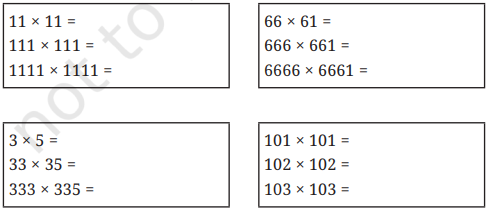

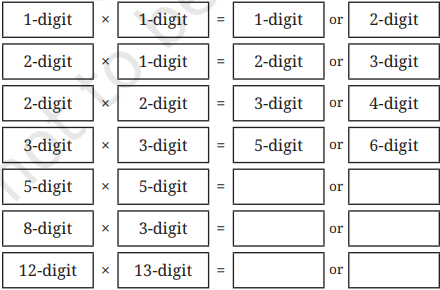
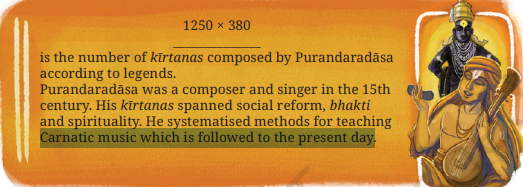

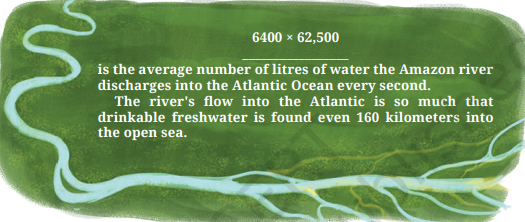

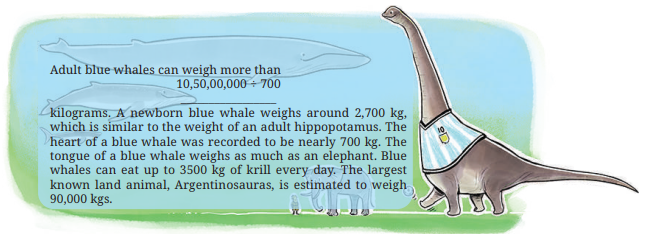
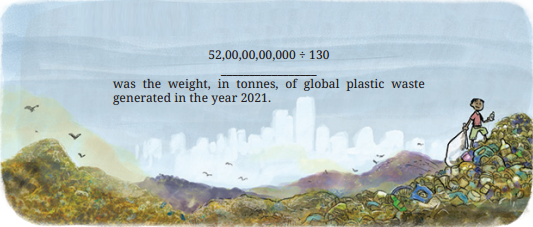



Leave a Reply